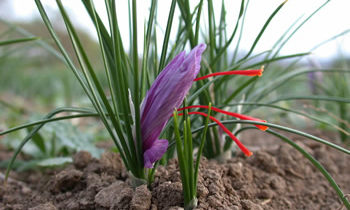
Sicilian Saffron
A flower that retains a unique power of the island of Sicily.
When its ready the flower petals open, a sign it’s time to harvest, bringing us one step closer to the intoxicating, concentrated, moving aroma that is at once medicinal and mesmerizingly wonderful in the kitchen.
Raval’s full story of saffron
A flower garden guarded by Etna. In this striking backdrop, from October to November when the first lights of sunrise call us to work, that the flowers haven’t yet unveiled the precious contents within their glass, and a few “wise” mothers scold us for our passion to harvest saffron.
We manage strictly by hand the entire cultivation and operations related to the production of saffron, from bulb to flower to harvest, without ever chemically tainting the face of mother nature. The separation of the strands is the most delicate phase because the filaments don’t all exhibit homogenous coloration; in fact the recognizable red hue is only visible from the part drawn from the flower, making it much more precious because it is richer in functional substances. The length of the strands is indicated by the continual whitening (lighter at the more profound levels) from bright yellow. The presence of absence of these hues determines the purity and properties of the spice – quality that is then clearly evidenced in the packaging.
Thanks to the particular climatic characteristics of the production area and our respect for nature, we obtain a “life long elixir”: saffron is recognized for counteracting age, stimulating metabolism, promoting digestive functions, reducing blood pressure, and lowering cholesterol and triglyceride levels.
The high content of carotenoids, crocetin, crocina and microcrocina makes saffron an extraordinarily rich antioxidant; carotenoids bind to free radicals and neutralize them, thus increasing immune defenses.
As humans, we each individually produce about 5 grams of radical waste every 24 hours. A diet enriched with saffron could eliminate as much as 20% daily. Thanks to numerous active principles, this spice increases the secretion of bile and gastric juices by stimulating and thus favoring digestive functions.
Dried at a maximum temperature of 45 degrees C on the same day of harvest, the properties – even at a medicinal level – remain in tact.
Dried and not toasted, therefore suitable for great gastronomy as it is not contaminated with resin or the smells of wood.
Cultivated naturally, in family: great attention to quality and no use of pesticides, herbicides, etc.
It is difficult to remain integrated in a society that is full of disparities, so polluted by irreparably destroyed consciences. And yet, there are still those of us who have taken the road less traveled; a road that is filled with the scent of our olive oil and the colors of our grain, which is removed from the vices of globalization, projected into a “glocal” dimension, paved by love and passion for one’s work. In this way we uphold our territory, rediscovering saffron from our ancestry and introducing the innovative culture of asparagus and other secrets of quality.
